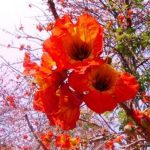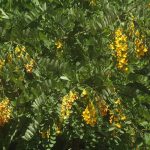TREE LIFE
December 2004
The Chairman and members of the Committee wish all members and their families a very happy Christmas, and many interesting walks in 2005.
MASHONALAND CALENDAR
Sunday 5th December. The date for our Christmas Social has been brought forward a little. We are very lucky to have been able to reserve the educational center at the Botanic Gardens, Fifth Street, for the whole day. All facilities are available so this is an ideal venue and there will be no charge at the gate. We would like to thank the Head of the Herbarium and Botanic Garden Nozipo Nobanda for this generous gesture to the Tree Society.
After tea which will be served at 9.30 am, we will have a short walk led by Meg Coates Palgrave, the subject Christmas Trees in Zimbabwe sounds like fun.
After the huge success of last years quiz, Rob and Adele have compiled another, and this test of GK will probably be before lunch or after, depending on time.
Please bring some Christmas fare to share for tea, and bring your own lunch, a wine glass and a chair. Terry Fallon has kindly offered to be on guard duty while we are walking in the garden.
Tuesday 7th December. Botanic Garden Walk.
Meet in the car park at 4.45 for 5 pm. This will be our opportunity to thank Tom for giving us so much of his time this year.
Saturday 1st January 2005. Mark’s first walk of the year will be in the grounds of the University.
Tuesday 4th January. Botanic Garden Walk.
MATABELELAND CALENDAR.
Please phone J P Felu on Bulawayo 232797 or Jonathan Timberlake on 286529 for details of the next Matabeleland function.
LOOMING NAME CHANGES IN THE GENUS ACACIA: An Update
In an article which appeared in the October 2004 edition of Tree Life (number 295) I summarized the very significant name changes which are about to take place in the genus Acacia. I am very grateful to Jonathan Timberlake for sending me a copy of a further paper [1] by R K Brummitt of Kew which takes the matter a step further.
Two factors are causing these name changes. The first is taxonomic research on the genus which implies the need to split up the genus into various smaller genera. The consequence of the first factor is that a substantial chunk of African species would need to be moved from Acacia into Senegalia, with the residual native species remaining Acacia. The exotic Australian weeds (wattles) would become Racosperma.
The second factor is the proposal by two Australian authors, Orchard and Maslin [2], to change the type species of the genus Acacia from what is now called A. nilotica to an Australian species.
The implication of the second factor would be that all our native Zimbabwean acacias would move to either Senegalia or to another genus Vachellia. Only the wattles would remain Acacia.
This article is concerned only with the second factor. In order to change the type, the proposal has initially to go before a committee of botanists who consider the arguments and vote on the proposal. The paper referred to above [1] sets out the result of the vote and the reasons for their decision.
The vote was in favour of the Australians proposal. The two principal reasons for this were as follows:
(a) the vastly greater number of species of Acacia (in the former sense) to be found in Australia than in the rest of the world. Acceptance of the proposals minimises name changes globally.
(b) that whatever the decision of the Committee is, there will still be significant name changes for users outside Australia, namely, in our case, the transfer to Senegalia.
A number of other arguments against the proposal were put forward and the paper explains why they were rejected. As some of these are quite interesting I am reproducing them below.
- It was argued that acacias are characteristic of Africa both in public perception and as an important vegetation type. However, the Committee felt that they were equally important in Australia: there they are the largest genus of flowering plants (more even than Eucalyptus) and an acacia is the national flower.
- The acacias are economically more important in Africa. Again, based on various, mainly Australian, sources, this view was rejected by the Committee.
- The widespread use of the name Acacia in floras outside Australia was referred to; but again this was rejected on the grounds that many name changes will take place anyway because of the taxonomic factor.
- The combinations needed in Racosperma (which would be the new genus for the Australian acacias if the proposal were rejected) have already been made (December 2003). However, despite their availability, the Committee felt that this should not be a factor in itself.
- Acceptance of the proposal will set a precedent and lead to many similar applications in future; this was felt to be unlikely by the Committee, which has never had to consider a proposal to stabilize over a 1000 names before.
Reference was also made to the changes to the genus Cassia, which led, in our case, to most species being transferred to Senna or Chamaecrista, leaving only two species in Cassia. There, the Committee points out, there appears to have been wide acceptance of the changes and no proposal to conserve Cassia was made.
Where does all this leave the Tree Society and the ordinary man in the street in Zimbabwe. There is no doubt in my mind that changes of name to such an important genus will cause a lot of unhappiness amongst members. I don’t think it will particularly matter whether those changes result from taxonomic opinion or international botanical decisions.
The case of Cassia is of some relevance. Many older members still use Cassia, but as the names (e.g. of Senna singueana) have been adopted in popular floras, so they have gradually become more accepted. However, Cassia is nothing like as important a genus as Acacia; it is neither so instantly recognizable nor as widespread nor as common nor so commonly encountered in our day to day lives.
Faidherbia is another example of a well-known species with a major name change. Again, this does seem to have been generally accepted, even if with a lot of muttering.
I would welcome any views on this subject. If members could email them or write to me, we can either publish them directly or I could summarize the opinions I receive in a future Tree Life. Should any further updates be necessary I will arrange for them to be published here as well.
-Mark Hyde
References:
[1] Report of the Committee for Spermatophyta 55: Proposal 1584 on Acacia. R K Brummitt in Taxon 53(3): August 2004: 826-829. [2] Orchard and Maslin in Taxon 52: 362-363, 2003.
BOTANIC GARDEN WALK: 5 OCTOBER 2004
The first walk was at the summer time of Tuesday evening and we welcomed Tom back from his holiday in Europe to lead us again.
There was no pre-set subject; Tom just discussed whatever came up that was of interest.
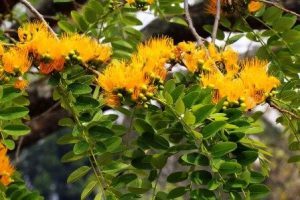
Cordyla africana. Photo: Bart Wursten. Source: Flora of Zimbabwe
The first species seen was Cordyla africana (the Wild Mango), a lowveld, riverine species. It has 1-pinnate leaves (with glandular dots and streaks) and fleshy fruits which somewhat resemble a mango. In the Gardens it was flowering and bearing its orange flowers and it looked very lovely indeed. Tom referred to very large trees which occur along the lower Save River, for example at Chipinda Pools.
A small, flowering Acacia nigrescens (the Knob thorn) showed the features of this tree species very clearly. The trunk was densely covered in the ferociously armed knobs; the flowers which were white were basically just finishing. The relatively large leaflets which are few in number were also seen. The flowers were in spikes and the thorns are curved prickles – should we call this Vachellia nigrescens? (See my article on the name changes in Acacia).
Ficus verruculosa is a locally common species of fig, occurring in riverine and wet situations. It is unusual in that it is quite small, usually up to about half a meter in Zimbabwe. Tom remarked that the figs made quite nice eating. A discussion took place about the strange nature of the “fig” and the relationship of the species with the fig wasps.
Newtonia buchananii (the Forest newtonia) occurs in forests in the Eastern districts at medium and low altitudes. Tom reckoned that the upper limit for it is 1300m. Like the Acacia nigrescens, the flowers are tiny and are arranged in spikes. As with most Mimosoideae, the leaves are 2-pinnate. Tom mentioned that this specimen in the wild would have a trunk 30 m high with a crown above that; however, here, in the open, the trunk was short and the crown effectively on the ground. The seeds of this species are winged – an unusual, possibly unique, feature within our Mimosoideae.
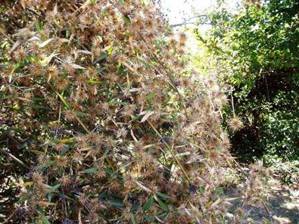
Oxytenanthera abyssinica. Photo: Mark Hyde. Source: Flora of Zimbabwe
Hurrying past a specimen of the Bindura bamboo, Oxytenanthera abyssinica, which was in flower, we came to a colony of wild gardenias in flower; these were Gardenia volkensii. Tom mentioned that this was a 1-day wonder with white flowers turning through various shades to yellowish-brown. It has a distribution which is difficult to understand, ranging from the edges of pans in the lowveld to sandy well-drained woodland.
A smallish Brachystegia glaucescens was in flower just above head height. It is not often that I’ve looked at the flowers of brachystegias, other than the msasa. This is obviously rather later-flowering than the latter species.
Parinari curatellifolia (the Mobola plum) is very well known to us all, but as Tom remarked, you don’t often notice the flowers, which are tiny and a very pale pinkish-lilac in colour. The tree often smells very badly and it doesn’t seem to be clear which part of the tree is responsible for this. Tom mentioned that it is extremely fire resistant with its thick bark,
Finally, near the Herbarium, we came across the national flower of Jamaica, Guaiacum officinale. Like Balanites, this has compound leaves with just two leaflets; the family is Zygophyllaceae (into which Balanitaceae is sometimes placed). The trees are a source of lignum-vitae and are some of the hardest commercial timbers.
-Mark Hyde
MARINGAMBIZI NATURE RESERVE, MTOROSHANGA: 17 OCTOBER 2004
In the hot and usually dry month of October, it is sometimes a bit difficult to find places where the trees actually have leaves and there is anything much to see. Our outing on this warm and moist summer’s day was once again to Maringambizi Nature Reserve, where we were the guests of Barbara Scheidler.
Our drive there took us along the road which runs northward on the western side of the Great Dyke. At some point, we turned at right angles away from the mountains into a fairly flat area broken by occasional scattered kopjes.
After assembling, we set off in our vehicles to a nearby area where camping is permitted (sadly quiet at the moment) and there are some nice rocky and woodland habitats. This was the same place we visited 2 years ago. To some extent our fears were realized as many of the trees were leafless with that peculiar combination of a wintry vegetation and high temperatures.
As some background, the altitude of the place was 1270 m, a bit lower than Harare, and certainly low enough for the trees to be different. One of the first trees we came across was difficult to name and caused a certain amount of debate and indecision. Our first attempt at the name was Euclea natalensis but eventually we decided its leaves were not dirty enough and we moved towards Diospyros kirkiana; later we considered D. mespiliformis, which was our eventual conclusion.
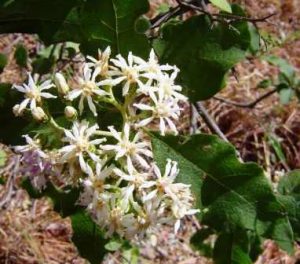
Vernonia colorata. Photo: Bart Wursten. Source: Flora of Zimbabwe
In the woodland was Vernonia colorata. This is one of the relatively few species in the Asteraceae which has a tree habit. It is also interesting in being winter-flowering. It is very close to Vernonia amygdalina but can fairly easily be separated by looking at the seeds (achenes); these have papillae only (minute nipple-like protuberances) in V. colorata but have hairs as well in V. amygdalina. The exact distinction in habitat between these two is not clear to me, but V. amygdalina seems to prefer higher-rainfall areas whereas colorata often favours drier stonier places.
Diplorhynchus condylocarpon (the Rubber tree) was present and was in flower. It has tiny white flowers with 5 lobes. Also seen was Afzelia quanzensis (Pod mahogany) together with some old pods to confirm the identification. The distinctive green peeling bark of Commiphora marlothii made identification of that species easy even without leaves.
In the woodland was Uapaca nitida (Narrow-leaved mahobohobo), the smaller-leaved cousin of the more common Uapaca kirkiana (the mahobohobo). We do occasionally see this species, usually to the north of Harare, but it is rather local. In this case, the trees bore fruit, which were smaller than those of the mahobohobo itself.
After a while we headed down towards the dam. Dark clouds were massing and there were distant rumbles of thunder. Here was a burnt area, on which the typical spring flora of pyrophytes, which we often see around Harare, was present.
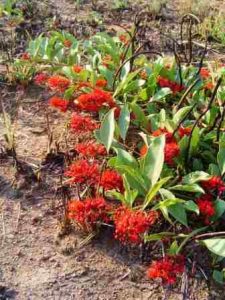
Combretum platypetalum. Photo: Bart Wursten. Source: Flora of Zimbabwe
Particularly attractive were the red flowers and fruits of Combretum platypetalum and also a very pretty orange-flowered herb, called Nesaea heptamera. The specific name means “with parts in 6s”.
Despite the thundery noises, we went on to visit the dam edge, and afterwards walked back to the cars, passing through some rocky hills. Here were the striking pale, peeling trunks of Albizia tanganyicensis and some fine specimens of Kirkia acuminata. In the end, the storms moved away and we had a very pleasant lunch sitting outside the cottages on the lawn.
It is of course unusual these days for us to go so far out of town for the day and perhaps because of this, or perhaps the cost of petrol, our numbers were well down and we just struggled into double figures. This is a pity as the Reserve is well worth visiting and we have plans to return there at a wetter time of the year when we hope that there will be more to see.
Our great thanks go to Barbara for hosting and guiding us throughout the day.
-Mark Hyde
THE PETHERAM FILES Continued..
Miscellany
This file, labelled Tree History Follow-up Papers, also contained what appeared to be the rough draft of an address to an unspecified group. The undated draft was entirely handwritten, and there was no evidence that it had ever got to the stage of being typed. Clues to a date for the draft were (1) an indication that Faidherbia albida was then becoming accepted as the correct name for Acacia albida, (2) a reference to a contribution by the author to the 1978 edition of the Gardening & Floral Diary, and (3) the use of the name Zimbabwe. We can probably take it that the material in this file was put together in the mid 1980s.
Trees and Wildlife
The leaves and shoots of a very wide range of trees are browsed by wild animals and often, for that matter, by domestic stock. Fallen leaves are also frequently taken, particularly when grazing has become poor.
The pods of numerous trees supply nourishment to game, and a favourite sight amongst Zimbabweans who visit Mana is that of elephant gorging themselves on the apple-ring pods of Faidherbia albida.
Mopane trees are highly prized for browse. Elephants love them, and the dry leaves, which are rich in phosphorus, are picked up by buffalo and other animals.
Boscia albitrunca (shepherds tree, or white-stemmed boscia) has particularly valuable foliage described in one book as good a feed as lucerne. The browse line makes the tree look as if a meticulous gardener has expertly trimmed it. The same sort of browse line is often a feature of trees at Mana Pools on the Zambezi, where Trichilia emetica (Natal mahogany) is so favoured by animals even grazing animals like impala when the grass runs out.
There seem to be mighty few trees that are not utilized in one way or another by wild life, although some with particularly nourishing properties naturally suffer more predation than others do. Even Spirostachys africana (tamboti), which has toxic properties as far as humans are concerned, are browsed on occasion by animals, mainly, perhaps, when the leaves are dry but not necessarily so, because porcupines gnaw the bark seemingly at any time.
Some additional trees, beloved of animals as dietary delicacies, are similarly distasteful to humans. Giraffe find our thorny acacias irresistible leaflets, thorns, and all. Only the sword swallowers amongst us would be likely to share this animal’s tastes!
The fruit of Pseudolachnostylis maprouneifolia (duikerberry) is a great favourite of the various antelope but it tastes ghastly! Xanthocercis zambesiaca (nyalaberry) that magnificent species, which grows particularly well in the Save-Limpopo Valley, and may be known to those who have visited the Rupisi hot springs has a fruit that is similarly popular with game animals, but is not a table dessert.
Black rhino have been known to munch, pensively, on the leaves of Obetia tenax (tree nettle) a tree that has the endearing quality of raising blisters on any human hand that happens to brush against its stinging hairs. The thorns of Gymnosporia buxifolia (spikethorn) do not seem to bother browsing impala, nyala, kudu, giraffe, or anything else.
At Mana Pools we have watched baboons enjoying the flowers of Kigelia africana (sausage tree), presumably for the nectar. The only animal I know that seems to eat the fruit is the rhino.
[Comment 2002: According to Malcolm Funston (1993), Bushveld Trees, the fruits of Kigelia africana are occasionally eaten by bushpig, and even more occasionally by baboons. AA Pardy (1953) Notes on Indigenous Trees and Shrubs of Southern Rhodesia, reported that unripe fruits are very poisonous, and ripe fruits inedible.]Marula (Sclerocarya birrea) fruits are relished by game and by humans, although some may find them a bit tart. Other wild fruits that are sought after by animals and humans are Berchemia discolor (bird plum, or brown ivory), Hexalobus monopetalus (shakama plum), Friesodielsia obovata (northern dwababerry), Parinari curatellifolia (muchakata, or muhacha), Uapaca kirkiana (mahobohobo), Tamarindus indica (tamarind), Cordyla africana (wild mango), Dovyalis caffra and D. zeyheri (kei-apples), Syzygium spp (waterberries), Englerophytum magalismontanum (stemfruit), various Diospyros species (sometimes called jackalberries or star-apples), Strychnos species (monkey oranges), Carissa species (num-nums), Vangueria and Vangueriopsis species (the so-called wild medlars), Artabotrys species (hookberries), Flacourtia indica (governor’s plum), Annona species (wild custard apples), and Garcinia species (mangosteens).
There are also, of course, the many wild figs that are all edible, but not all of them very palatable. Nonetheless, they are among the edible resources we share with our wild animals and birds.
Among the birds, every one of these wild fruits figures on the menu. Not all birds are predominantly fruit eaters, but those that are not are only too pleased to sip at the nectar-rich flowers of some of the fruit trees, or to take their choice of the insects and caterpillars, grubs and rodents that visit the flowers or fruits. This is why it is so vitally important to leave old and rotting (or composting) vegetation where it is, and not automatically to regard a leafless or broken branch as firewood. It is from old wood, the mosses, the fungi, and ant-ridden remnants of fallen bark and branches and seed pods that beetles and many other creatures emerge to help in the food chain of wild life, from the minutest of grubs to the most majestic of birds and animals. It is in the cracks and hollows of living trees and bushes that many of them nest and find shelter.
Lyn Mullin To be continued.
MARK HYDE CHAIRMAN


